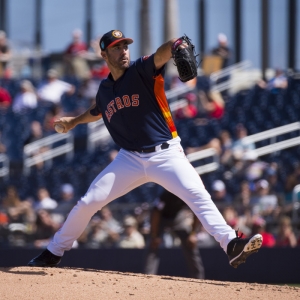Exit Velocity Stat: How to Use to Advantage in MLB Handicapping

Handicapping Major League Baseball pitching is crucial to your bankroll. Knowing what pitchers do well in certain spots, don't do well in certain spots, and how hitters capitalize, can be advantageous to cash tickets. One of the new advanced statistics MLB has implemented is Exit Velocity (measured in MPH). Exit Velocity (EV) is the velocity at which the ball exits the bat immediately after contact. This is relatively a new statistic since years ago we simply did not have the technology to record the data. Average Exit Velocity (aEV) is calculated by dividing the sum of all Exit Velocities by all Batted Ball Events.
A very important thing to keep in mind about this statistic is that the lower the number the better for the pitcher. So, an average of 88 MPH or lower puts you in the top 50 percent of the league, and 88 MPH or higher puts you in the bottom half of the league. Much like golf, the lower your number the better.
Variables
There are many variables to Exit Velocity:
Bat Speed - Bat Speed Impact is the measured MPH of the velocity of the barrel of a players' bat when the bat impacts the ball.
Pitch Speed - Pitch Speed is important; faster pitches will be able to produce a higher EV than slow-moving pitches.
Ball Point of Contact - Hitting the ball squarely in the center of the radius will impact EV.
Weight of The Bat - If the player can swing a heavier bat with the same bat speed as a lighter bat, the ball will travel off the bat at a higher speed.
Hardness of The Bat - This is why MLB uses wood bats instead of metal like college baseball. The exit velocity with MLB players using metal bats would be so incredibly high it would be unsafe for the pitcher 60 feet, six inches away. Not to mention we would have guys hitting 100 home runs a year.
Hardness of The Ball - This is a current dilemma in baseball, as pitchers believe MLB is "juicing" the baseballs. Simply put, the newer the baseball the better for EV. Therefore, the umpire usually gives the pitcher a new ball after every batted ball (fair or foul). The more a baseball gets hit, the softer it becomes. It may take about 100 points of impact before you see an effect on EV, but all those batting practice balls will start to soften over time.
How can we use this for handicapping?
The biggest factor to help us here, is handicapping the pitcher using "Exit Velocity Against" or EVA. Pitchers who get hit harder than other pitchers don't necessarily have higher ERA's because of the "luck" factor. Sometimes a pitcher might throw a complete game shut out, but 15 of the outs were line drives that simply were hit directly at fielders. Outings like that are unsustainable, and eventually the numbers will turn around. Therefore, a good trick is to see a pitcher whose EVA is very high, but he has a good ERA or record. Sooner rather than later he'll get rocked. Knowing what starting pitchers have the highest EVA can help us with "over" plays, or simply "fading" that pitcher and taking the other team.
A few examples
Alex Cobb of the Baltimore Orioles has the highest average EVA in the league currently at 94.9 MPH as of 5/6/2019. Consequently, he is 0-2, with a 10.95 ERA and 1.86 WHIP. These numbers align, so to speak. Since so many hitters are squaring up his pitches, he is giving up many hits and nine home runs in three starts. In his three starts, the Orioles went 0-3 SU, 1-2 vs. the RL, and the O/U was 2-1.
CC Sabathia is among the best in EVA ranking number 35th in MLB. Consequently, he is 1-1, with a 2.66 ERA and 1.03 WHIP. These numbers also align as the Yankees are 3-1 in four starts and 1-2 O/U when he takes the hill.
What's the bottom line?
Starting pitchers ranking low in EVA are good fades vs. the moneyline, run-line, and "on" the OVER. Conversely, starting pitchers ranking high in EVA are great wagers "on" the moneyline, run-line, and "on" the UNDER.
This is great for "Team Totals" also, as you only need to rely on the one pitcher you are either fading or wagering on.
The EVA statistic is also fantastic for first five inning plays, as you typically won't have the bullpen involved. If you are playing on a pitcher with a fantastic EVA (moneyline or "under") on a first five inning play, you only need them to be themselves for five innings and not have the bullpen come in and possibly blow it later.
If you are "fading" the pitcher with the bad EVA, and playing moneyline or "over", if the bullpen does get involved within the first five innings, you are probably going to cash the ticket.
Most Recent Sports Betting 101
- NHL First Period Betting Advice and Strategy
- Football Betting Sportsbook House Rules for NFL and NCAA Wagering
- Baseball Betting Sportsbook House Rules for MLB and College Wagering
- How do I Bet Soccer?
- Understanding and Learning How to Calculate Expected Value EV for Sports Betting
- Avid NFL Bettors Benefit From Multiple US Sportsbooks
- What are College Football Picks: A Comprehensive Guide
- What are NBA Basketball Picks: A Comprehensive Guide
- Book Review: “Gambler: Secrets from a Life at Risk” by Billy Walters
- How to Make an NFL Game Winner Prediction (NFL Picks)
